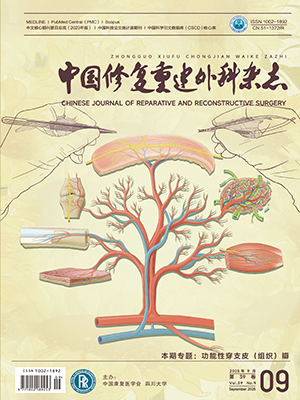| 1. |
Abbasi H, Abbasi A. Oblique lateral lumbar interbody fusion (OLLIF): technical notes and early results of a single surgeon comparative study. Cureus, 2015, 7(10): e351.
|
| 2. |
管俊杰, 石志才.腰椎动态固定技术的临床研究进展.脊柱外科杂志, 2010, 8(1): 59-62.
|
| 3. |
Yugué I, Okada S, Masuda M, et al. Risk factors for adjacent segment pathology requiring additional surgery after single-level spinal fusion: impact of pre-existing spinal stenosis demonstrated by preoperative myelography. Eur Spine J, 2016, 25(5): 1542-1549.
|
| 4. |
Wang Q, Liu J, Shi Y, et al. Short-term effects of a dynamic neutralization system (Dynesys) for multi-segmental lumbar disc herniation. Eur Spine J, 2016, 25(5): 1409-1416.
|
| 5. |
Perez-Orribo L, Zucherman JF, Hsu KY, et al. Biomechanics of a posterior lumbar motion stabilizing device: in vitro comparison to intact and fused conditions. Spine (Phila Pa 1976), 2016, 41(2): E55-63.
|
| 6. |
鲁凯伍, 瞿东滨, 张树芳, 等.经皮内窥镜下腰椎间盘切除术治疗外侧型腰椎间盘突出症.中国脊柱脊髓杂志, 2010, 20(2): 107-111.
|
| 7. |
Modic MT, Ross JS. Lumbar degenerative disk disease. Radiology, 2007, 245(1): 43-61.
|
| 8. |
Stoffel M, Behr M, Reinke A, et al. Pedicle screw-based dynamic stabilization of the thoracolumbar spine with the Cosmic-system: a prospective observation. Acta Neurochir (Wien), 2010, 152(5): 835-843.
|
| 9. |
Cheh G, Bridwell KH, Lenke LG, et al. Adjacent segment disease followinglumbar/thoracolumbar fusion with pedicle screw instrumentation: a minimum 5-year follow-up. Spine (Phila Pa 1976), 2007, 32(20): 2253-2257.
|
| 10. |
De la Garza-Ramos R, Kerezoudis P, Sciubba DM, et al. The effect of preoperative diagnosis on the incidence of adjacent segment disease after lumbar fusion. J Neurosurg Sci, 2015. [Epub ahead of print].
|
| 11. |
Kyaw TA, Wang Z, Sakakibara T, et al. Biomechanical effects of pedicle screw fixation on adjacent segments. Eur J Orthop Traumatol, 2014, 24 Suppl 1: S283-287.
|
| 12. |
潘志强, 叶立民, 王求永, 等.腰椎融合术后临近节段椎间盘应力的有限元分析.中外医学研究, 2014, 12(17): 20-22.
|
| 13. |
Tang S, Xu W. Does disc space height of fused segment affect adjacent disc degeneration in anterior lumbar interbody fusion? A radiological study. Iran Red Crescent Med J, 2012, 14(3): 139-145.
|
| 14. |
Masevnin S, Ptashnikov D, Michaylov D, et al. Risk factors for adjacent segment disease development after lumbar fusion. Asian Spine J, 2015, 9(2): 239-244.
|
| 15. |
Mulholland RC, Sengupta DK. Rationale, principles and experimental evaluation of the concept of soft stabilization. Eur Spine J, 2002, 11 Suppl 2: S198-205.
|
| 16. |
李尔楠, 叶启彬, 匡正达.脊柱非融合内固定系统在腰椎退行性疾病治疗中的应用进展.检验医学与临床, 2014, 11(24): 3496-3498.
|
| 17. |
Niu CC, Yuan LJ, Chen LH, et al. Beneficial effects of hyperbaric oxygen on human degenerated intervertebral disk cells via suppression of IL-1βand p38 MAPK signal. J Orthop Res, 2011, 29(1): 14-19.
|
| 18. |
吴剑宏, 阮狄克.腰椎间盘退变的MRI诊断分级及其临床应用进展.中国脊柱脊髓杂志, 2010, 20(6): 511-515.
|
| 19. |
楼才俊, 陈其昕, 李方才, 等.腰椎间盘髓核退变的MRI表现与病理学的相关性研究.中华骨科杂志, 2005, 23(9): 531-535.
|
| 20. |
Périé D, Curnier D. Effect of pathology type and severity on the distribution of MRI signal intensities within the degenerated nucleus pulposus: application to idiopathic scoliosis and spondylolisthesis. BMC Musculoskelet Disord, 2010, 11: 189.
|
| 21. |
Gao J, Zhao W, Zhang X, et al. MRI analysis of the ISOBAR TTL internal fixation system for the dynamic fixation of intervertebral discs: a comparison with rigid internal fixation. J Orthop Surg Res, 2014, 9: 43.
|




